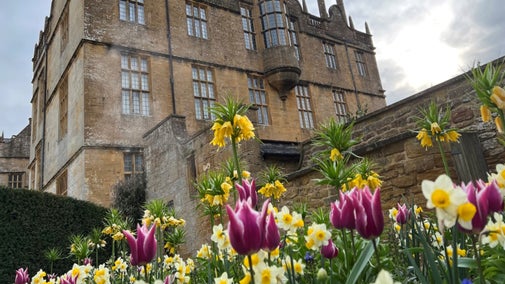
Discover more at Tintinhull Garden
Find out when Tintinhull Garden is open, how to get here, the things to see and do and more.

Created last century around an attractive 17th-century manor house, Tintinhull Garden is one of the most harmonious small gardens in Britain. It features secluded lawns, pools and imaginative borders. You can also explore the attractive Kitchen Garden and Arboretum.
The blues lias pathway draws the eye from the house across the most formal garden to the Middle Garden, and down to the Fountain Garden at the far end. The stone eagle sculptures on top of the original gate pillars give this area its name. In Eagle Court, the use of particular plants and colours combines the best of both Phyllis Reiss’ and Penelope Hobhouse’s contribution to the garden. This garden offers a colour scheme of blues and yellows with year-round interest for everyone.
Previously dominated by shrubs and small trees, this garden has undergone a transformation in recent years. Drawing inspiration from Penelope Hobhouse, new shrubs have been added to the borders, providing vibrant color and interest throughout the year. The view from the summerhouse to the memorial urn has been restored, and the addition of a newly carved bench offers a fresh perspective of the garden.
Virtually hidden until the last moment, the central feature here is a circular lily pool with a simple fountain enclosed by yew hedges. The borders surrounding the pond were rejuvenated in 2021 and are filled with white roses and other flowering plants. A new stumpery has been added to the approach of the Fountain Garden using trees that had to be felled on the wider estate. In spring, the Tulips and Alliums bloom, but as late summer approaches, the area becomes more muted, offering a quiet and shaded retreat from the summer sun. This garden is flanked with two large Cornus Controversa that help highlight the shady seating area.

This area was designed as a space for reflection, with contrasting borders of warm and cool colours facing each other. Containers play an important role here, with large planters in the corners of the pool providing even more colour and structure through the seasons. The summerhouse provides shelter from rain and the sun, and a relaxing vantage point from which to enjoy the water. As we move from spring to summer, water lilies flowers adorn the pond and wildlife such as dragonflies and newts become frequent visitors. The heady scent of the roses in late summer enhances an afternoon relaxing in this space.
Cedar Court is named after the Cedar of Lebanon that is is visible from almost every vantage point around the garden. Here you will find beautiful magnolias flowering in spring and late summer. The Magnolia Grandiflora provides a lovely frame to a seating area where you can appreciate the pristine lawns, and purple and gold border. Taking inspiration from both Phyliss Riess and Penelopy Hobhouse, this border showcases the diversity of the colour purple, ranging from deep blues to almost dark reds. This garden also includes Rosa ‘For Your Eyes Only, that repeat flowers throughout the year, ranging from deep red to a soft pink.

Thanks to the vision of Phyliss Riess and Penelope Hobhouse, the Kitchen Garden boasts an array of fruits, vegetables, and edible flowers, including dahlias and hollyhocks. Visitors can contribute a donation to take home some of the produce, with sweet peas being particularly popular. The flowers also play a crucial role in supporting the Kitchen Garden by attracting pollinators.
Behind the formal garden is the peaceful arboretum, a beautiful area of woodland that provides a contrast to the formal garden. Today it is a secluded oasis where people can enjoy a walk or spread a blanket for a picnic.

Find out when Tintinhull Garden is open, how to get here, the things to see and do and more.

Find out about making a group booking at Tintinhull Garden, or combining it with a visit to other National Trust places nearby in South Somerset if you’d like to make a day of it.

The delightful Tintinhull Garden in Somerset was created around a 17th-century manor house by two 20th-century gardeners. Discover how it grew around the vision of these two women.

From 18th-century water gardens and Arts and Crafts landscapes to intimate woodland gardens, there are so many places to discover.

Discover our gardeners’ top tips so you can make the most of your garden, plot or window box.

The Somerset area has some wonderful gardens filled with fountains, lakes and terraces. Here are the perfect places to explore this winter season.